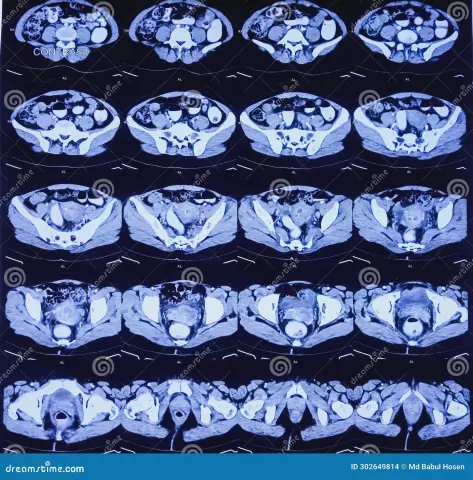- Author Rachel Wainwright [email protected].
- Public 2023-12-15 07:39.
- Last modified 2025-11-02 20:14.
Dysplasia of the cervix

Cervical dysplasia is a condition of the mucous membrane of the cervix and vagina, in which the appearance of cells of atypical structure is observed. Changes affect not only the structure, but also the normal functioning of the surface layer of the cervix. It should be remembered that cervical dysplasia is a precancerous condition. Of course, this does not mean that cancer already exists or will appear in just a couple of days or weeks. This means that in the absence of full-fledged treatment several years after the diagnosis is made, the development of a cancerous tumor is possible.
Quite often, cervical dysplasia is mistakenly called erosion. The difference here is that in the first case, the changes affect the entire cellular structure, while erosion is characterized by mechanical damage to the mucous membranes of the cervix.
Causes of cervical dysplasia
To date, many reasons have been identified that contribute to the appearance of cervical dysplasia. They can be conditionally divided into two groups:
- Infection with the human papillomavirus (HPV) of the oncogenic type. This cause of cervical dysplasia is a priority in 90-95% of all cases of the disease.
- other causes of cervical dysplasia, which, under certain circumstances, can become a starting point for the development of the disease. In 5-10% of cases of development of dysplasia, inflammation of the female genital organs of a protracted nature, hormonal disorders caused by pregnancy, menopause and / or prolonged use of hormonal contraceptives are included.
A risk factor is a decrease in immunity as a result of stress, chronic illness, drug overload, smoking and alcohol abuse. The cause of cervical dysplasia can be early onset of sexual activity, the presence of a large number of sexual partners, abortions and even multiple births. One cannot ignore heredity, if one of the blood relatives suffers from oncological diseases of the female genital area, then the likelihood of cervical dysplasia increases several times.
Symptoms and stages of dysplasia

The disease is asymptomatic, only in advanced cases, a woman may experience a feeling of discomfort during and after intercourse, pulling pains in the lower abdomen and minor bleeding from the vagina, not associated with menstruation. Dysplasia of the cervix, depending on the depth of the lesion of the mucous membrane, is divided into three stages:
- easy (I degree). Atypical cells penetrate only one third of the entire thickness of the mucous membrane. Self-healing is possible in 70-90%.
- moderate (II degree). In this case, atypical cells occupy two thirds of the thickness of the mucous membrane. In about half of cases, the disease goes away on its own. In the third stage, cervical dysplasia passes in every fifth patient. In five women out of 100, the disease ends with a cancer.
- severe (stage III). The defeat covers the entire thickness of the surface layer of the cervix. As in the case of the second degree of lesion, in 50% a complete recovery is possible. In the second half of the patients, this stage of the disease progresses to cervical cancer.
Very often, cervical dysplasia occurs in conjunction with gonorrhea, chlamydia, genital warts of the vagina, anus and vulva. It is also often accompanied by a microbial infection, which is manifested by symptoms of cystitis and cervicitis (inflammation of the cervix).
When making a diagnosis of cervical dysplasia, symptoms, as having no practical value, are not particularly taken into account, the emphasis is on laboratory, clinical and instrumental studies.
Treatment of cervical dysplasia
Based on the data obtained after the examinations, as well as taking into account the age, stage of the disease, the size of the lesion, the presence of concomitant diseases and the general condition of the patient, a method of treating cervical dysplasia is determined. The modern level of medicine allows you to completely get rid of the disease at any stage.
With the first degree of damage, most often no specific treatment for cervical dysplasia is required, but regular observation by a specialist within the time frame specified by him is desirable. The second stage of cervical dysplasia is successfully treated with a course of conservative treatment. For this, the focus of infection is improved, immunostimulating therapy and a course of treatment with anti-inflammatory drugs.
In case of ineffectiveness of treatment or severe dysplasia, surgical treatment is recommended, in which the altered tissues are removed using various methods. Cauterization with an electric arc, laser, radio waves, as well as freezing of lesions with liquid nitrogen is widely used. In advanced cases, you have to resort to amputation of the cervix.
Treatment of cervical dysplasia with folk remedies
For the treatment of cervical dysplasia, folk remedies, as well as for any other diseases, are widely used. But it should be remembered that the use of non-traditional therapy methods is not always justified, especially if the recipes recommend douching with medicinal infusions and insert tampons soaked in them. Mechanical injury to an already damaged mucous membrane can lead to a worsening of the condition. In addition, self-medication gives an imaginary hope of recovery, and this, in turn, leads to a refusal to follow up with a specialist, which is fraught with complications, up to the development of cancer.

In addition to douching, treatment of cervical dysplasia with folk remedies means taking decoctions and infusions of medicinal herbs inside in the form of a drink, which is a safer method of getting rid of the disease. The course of treatment is two weeks, then a break is taken. From medicinal plants in the treatment of cervical dysplasia with folk remedies, clover, licorice, sage, anise, soy, alfalfa, oregano and hops are successfully used. These herbs can not only be brewed, but also added to food. In addition, you need to review your diet. It is advisable to increase intake of fresh fruits, tomatoes, whole grains and soy products.
Regular observation by a specialist, timely treatment of foci of infection, streamlining of sexual activity, adherence to the rules of personal hygiene and the inclusion of a sufficient amount of vitamins and microelements in the daily diet will help to avoid such a formidable disease as cervical dysplasia.
YouTube video related to the article:
The information is generalized and provided for informational purposes only. At the first sign of illness, see your doctor. Self-medication is hazardous to health!






